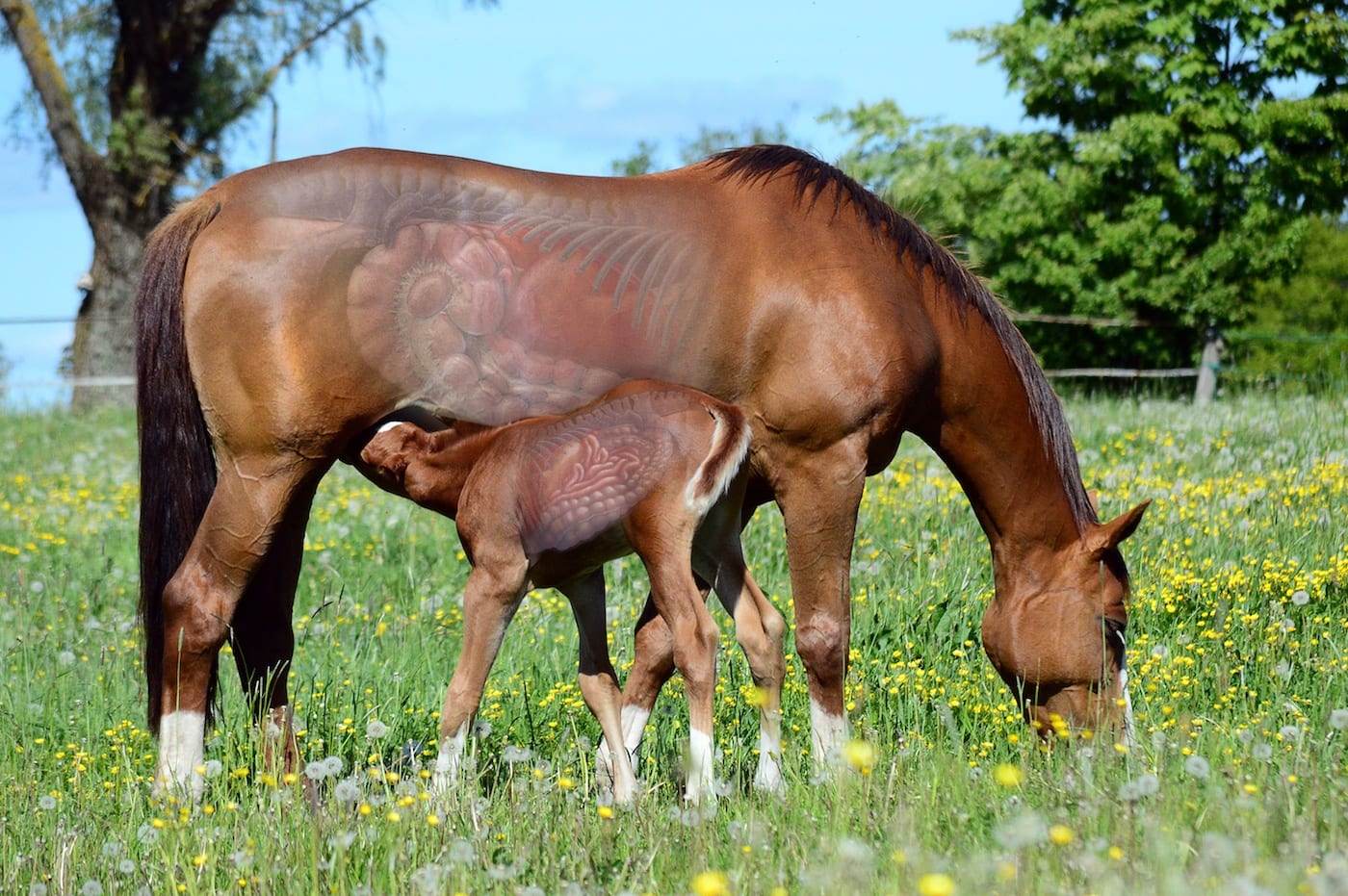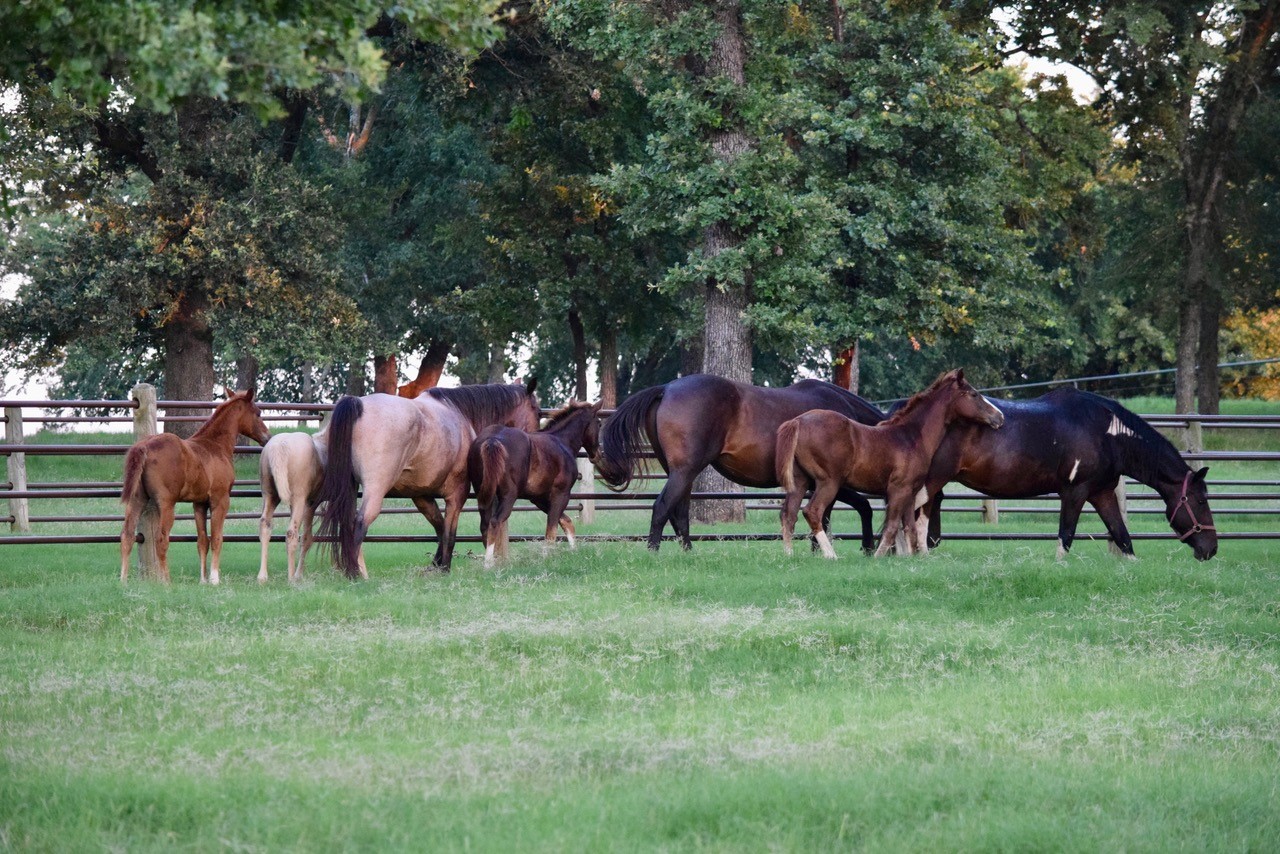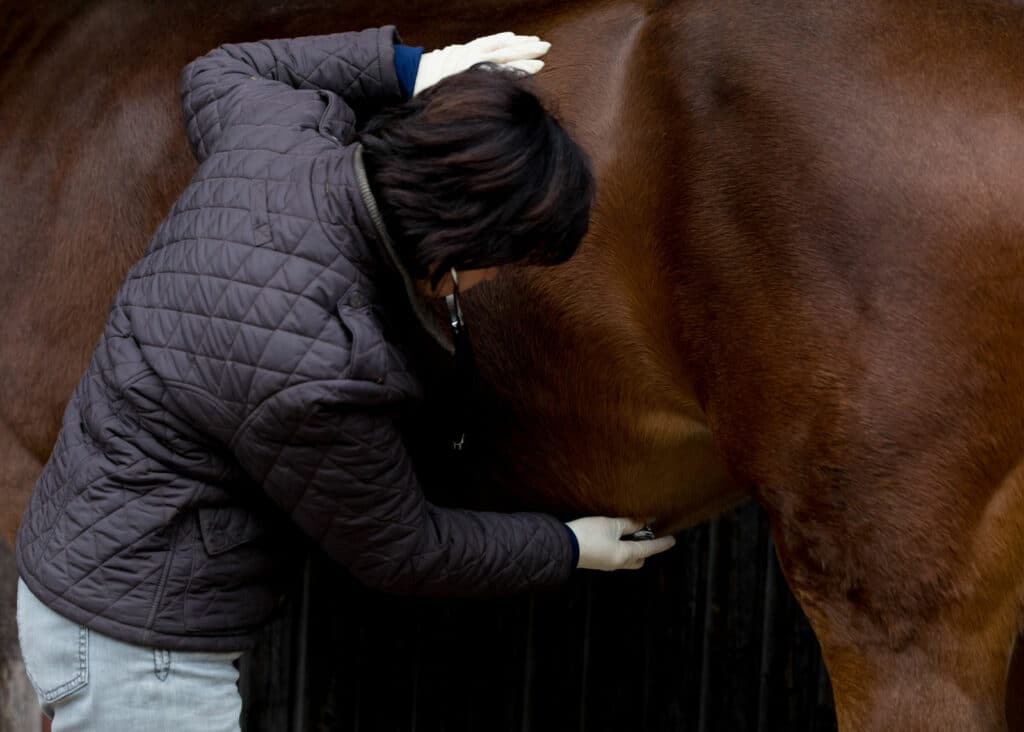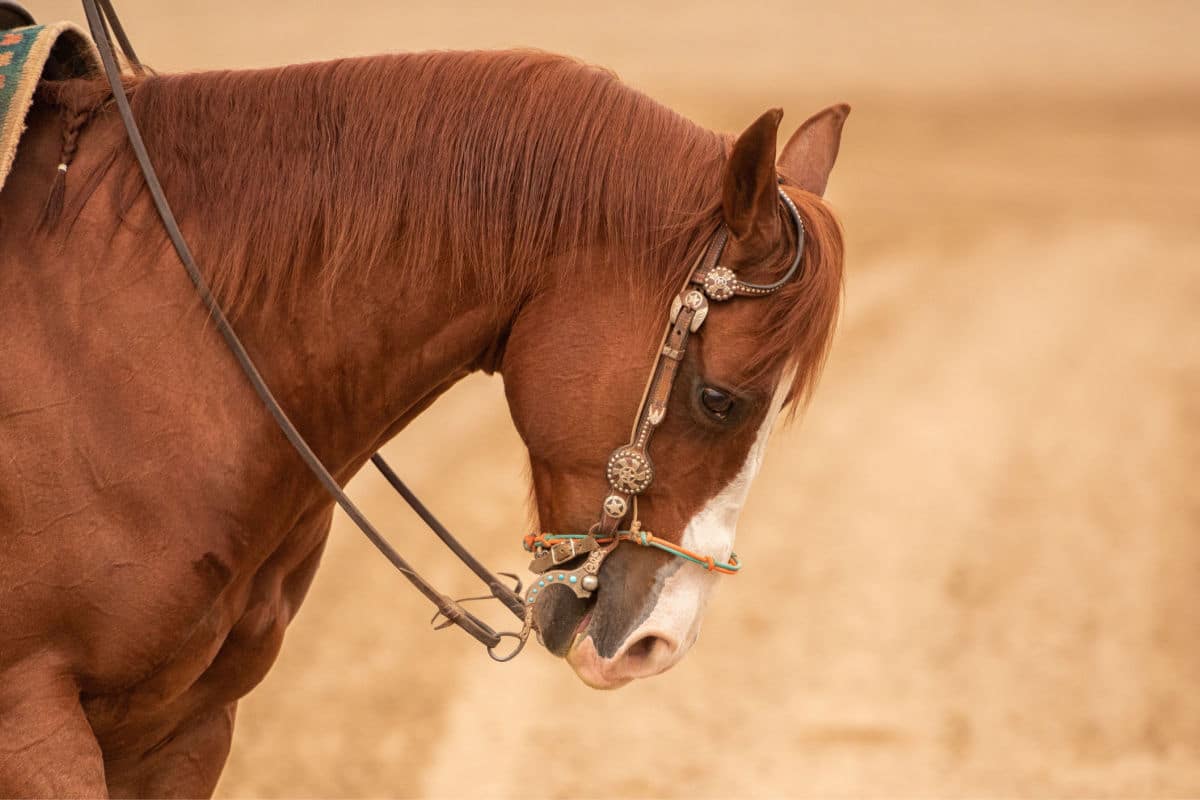We’re currently undergoing a surge of interest in healthy “gut bacteria” and its impact on overall wellness in both the human and horse worlds. These markets continue to explode with new research on the far-reaching effects of gi tract health (and products to support it). For our horses, healthy hindgut microbiota—which involves more than just bacteria—is critical.
Learn how the intestinal microbiota contributes to both health and disease in horses and how you can influence it with proper feeding and management practices.
Intestinal Microbiota and Digestion in Horses
The equine digestive system begins in the mouth with chewing and proceeds through the esophagus, stomach, small intestine, large intestine and finally the rectum. The horse’s large intestine (commonly referred to as the hindgut) includes the cecum and the colon, which together can hold up to 32 gallons of fibrous feed material as it ferments for several days. While bacteria and other microorganisms found throughout the gastrointestinal tract play important roles in health, the hindgut is most significant. There the microbiota works to break down food so the horse can absorb the nutrients. This is why the horse is known as a “hindgut fermenter.”
The horse’s intestinal microbiota is composed of several types of microorganisms:
- bacteria,
- archaea,
- eukarya (protozoa and fungi),
- and viruses (which help to control bacterial populations).
The specific composition of the types of microorganisms within the gut is unique to each horse, influenced by factors such as genetics, diet, environment and changes in gut balance (Martin et al, 2017). As a result, when we refer to a healthy microbial population in the horse, we must understand that this healthy balance is specific to each individual horse. The make-up of the microbiota begins developing within a horse’s first few days of life.
In horses, the hindgut microbiota plays the central role in digesting fiber—the bulk of the equine diet. These microorganisms are responsible for breaking down structural carbohydrates, as found in grass, hay, beet pulp and other forages, so that the horse’s body can absorb and use their nutrients.
This process results in the production of volatile fatty acids (VFAs), which are then converted to energy sources for the horse. Fermentation of forage in the hindgut provides up to 70 percent of a horse’s energy requirements. The microbiota also produces some vitamins, especially vitamin K, and some B vitamins like folate.
Research on Intestinal Microbiota, Health & Disease
Scientists and researchers have only just begun to really understand and study the microbiome. And what we do know increases dramatically every year. The more we learn, the more we appreciate the importance of the microbiota to health and wellbeing. In horses, the following research is underway:
- Classification of the Equine Microbiome e.g. the Equine Microbiome Project.
- The effect of diet on the microbiome, and the impact on the long-term health of the horse.
- How the microbiome changes as foals grow into adults and what are the influential factors on this.
- How do stressors such as training, travel, foaling, anesthesia and surgery affect the microbiome?
- How do antimicrobials and anthelminthics affect the microbiome?
The results of these research studies are not definitive yet. However, early findings show a large amount of individual variation in the microbiota, which indicates that a “standard” microbiota for horses may not exist. They do see some general patterns in the species that make up the equine microbiota, including Firmicutes and Bacteroides, but their percentages vary considerably.
Also, evidence is emerging that the microbiota is involved in more than just food digestion. The microbiota, and various metabolic by-products of the organisms themselves:
- Interact with the immune system
- Interact with the neurologic system
- Interact with the endocrine system
- Participate in various aspects of normal metabolism
- Tricarboxylic acid cycle
- Bile acid recycling
- Glucose-insulin feedback loop.
With multiple systems affected, it becomes even more important to maintain a healthy microbiota.
Disturbances to the Equine Microbiota
Serious disturbances of the hindgut microbial population can lead to a condition known as dysbiosis. Dysbiosis refers to a profound imbalance in a horse’s intestinal microbiota that results in changes to the normal health and function of the equine digestive tract. It can result in colitis, laminitis, colic and other clinical situations.
Such large-scale disturbances of the intestinal microbiota are known to occur after a sudden change in a horse’s diet. Antibiotic-induced colitis is also a well-recognized form of dysbiosis.
While the makeup of the microbial environment varies from horse to horse and is an area of ongoing research, one thing we do know is that diversity is key. Dysbiosis is known to be associated with fewer species of microorganisms in the gut.
Symptoms in your horse that could potentially be related to dysbiosis include:
- Colic
- Weight loss and ill thrift
- Periodontal disease
- Obesity and laminitis
- Neurologic disease
- Neonatal maldevelopment
Additionally, recent research findings indicate that more subtle changes in the microbial population of the horse are even more common and can have health implications. These can result from smaller changes to a horse’s diet or from diets heavy in complex carbohydrates such as grain.
The Microbiota’s Role in Equine Diseases
To date, veterinarians and researchers only know a small amount about the extent of the effect of an imbalanced microbiota. Here’s what they do know so far.
Colitis in Horses
Changes to the intestinal microbiota cause inflammation of the mucosal lining of the large intestine (known as colitis) and dysfunction of the cells. This could lead to diarrhea, damage to the bowel and systemic inflammation and infection.
Species that may be linked to colitis include the bacteria Lachnospiraceae and Ruminococcaceae. These have been associated with intestinal health in other mammals and have been found to be significantly lower in abundance in horses with diarrhea. Also, Actinobacteria and Spirochetes species have also been found to decrease in horses with idiopathic colitis, while Fusobacteria species increase.
The role these bacteria play, along with the better known causes of colitis such as Salmonella and Clostridium difficile, are yet unknown.
Colic in Horses
The microbiota produce gas as a side effect of their metabolic processes. This is likely to impact the development of gas-related colics and large colon torsions. Intestinal motility may also be affected by the by-products of microbial metabolic process.
Few studies have yet shown a direct link between certain microbial disturbances and colic. However, in a study on pregnant mares, it was found that when a change in the microbiota was detected the mare was significantly more likely to develop colic (Weese et al. 2015).
Laminitis
Laminitis has long been associated with dietary changes, such as ingestion of lush grass and grain-overload. The interplay between dysbiosis, intestinal inflammation and the development of laminitis are well studied. However, the precise details of whether certain strains of bacteria have a bigger influence are yet unknown.
Equine Gastric Ulcer Disease
Since Helicobacter bacteria were discovered to be involved in the pathology of gastric ulcers in humans, a microbial influence has been suspected in horses. The role of bacteria and how the diet can cause or prevent gastric ulceration is an area of ongoing research.
Equine Metabolic Syndrome (EMS)
The links between obesity, disorders of glucose-regulation and the microbiota are being intensively researched in humans, and have led to similar investigations in horses with EMS. One study so far has found that horses with EMS have decreased microbial diversity. The interplay between the microbiota and the horse’s metabolism and endocrine system is highly complex.
Diagnosing and Treating Dysbiosis in Horses
Dysbiosis represents a serious health issue, but, unfortunately, veterinarians have no easy way to diagnose it at this time. They are often limited to relying on whether or not the horse responds well to treatment. In some cases, tests or screenings may indicate the causative agent such as a certain bacteria or toxin—if one is involved.
It’s also important to understand that even a minor imbalance in the microbial population of the hindgut can negatively affect health and performance.
Tests a veterinarian may use to help identify dysbiosis include:
- A fecal occult blood test such as the SUCCEED Fecal Blood Test, a non-invasive, inexpensive, and reliable diagnostic tool that uses antibodies to detect occult blood components in your horse’s manure.
- Biopsy of the intestine or rectum.
- PCR panels to screen for:
- Any obvious change to the microbial profile (these profiles are not currently readily available).
- The presence of pathological agents (bacterial, viral, helminthic).
But because each horse’s microbial environment is different, treating dysbiosis can be complex.
Some vets may recommend probiotics, or “good” live microorganisms, which are added to feed to “replenish” the population in the gut. However, research has yet to show significant benefits to horses fed probiotics.
Alternatively, prebiotics provide a nutrient source for microorganisms. This may be helpful in encouraging the growth of beneficial bacteria. Prebiotics can include fructooligosaccharides (FOS), xylooligosaccharides (XOS), polydextrose, mannon oligosaccharides (MOS), galactooligosaccharides (GOS), pectin and psyllium.
For horses with chronic diarrhea, fecal transfaunation (transplanting stool from a healthy horse into the rectum of a diseased one) has been shown to significantly improve intestinal health.
While encouraging a healthy microbial population can include these nutritional supplements and approaches, the best method is simply good feeding and management.
Encouraging Microbiota Health in Horses
As with anything, prevention is always the best medicine when it comes to your horse’s microbiota and intestinal health. Maintaining a healthy intestinal function with proper feeding and management is crucial to microbiota (and overall) health.
DO:
- Feed a forage-first diet. Your horse’s feed program should be predominantly high quality hays and/or grasses
- Feed forage free-access. The equine digestive system functions best with a constant, steady trickle of forage. Offer more, smaller meals throughout the day (and night), use hay nets or slow feeders, or extend pasture turnout to increase grazing.
- Minimize the amount of grain. Feed less grain, and, where possible, feed beet pulp or supplement with high quality oils as alternative energy sources.
- Encourage plenty of movement. Turnout is best, but horses need to be kept moving regularly on the outside for digestion to stay moving properly on the inside.
Horses, especially those used in breeding or performance, often benefit from added digestive support. Certain naturally occurring nutrients such as polar lipids, beta glucan, yeast and nucleotides have been shown to encourage good digestive health.
DO NOT:
- Keep horses confined in stalls around the clock.
- Feed grain meals larger than 4-5 lbs.
- Limit the amount of hay or grazing offered.
- Make changes in feed quickly.
In conclusion, the intestinal microbiota plays a critical role in a horse’s health. With proper feeding and support, a healthy microbiota contributes to good digestion and nutrition as well as immune and neurologic function. When it becomes imbalanced or diseased, it can play a role in colitis, colic, laminitis and other serious diseases. And we are only beginning to understand the microbiota in horse health and disease.
We must take every step possible to ensure good feeding and management—for a healthy microbiota and a healthy horse.
References
Julliand, V. and Grimm, P. (2016) Horse Species Symposium: The microbiome of the horse hindgut: History and current knowledge. Journal of Animal Science.
Martin, E.J. et al (2017) Normal variation and changes over time in the equine intestinal microbiome. Abstract. Journal of Equine Veterinary Science, 52, p 60.
Weese, S. (2017) Role of the Equine Microbiota in Health and Disease. ACVIM conference proceedings.
Weese, J. S., Holcombe, S. J., Embertson, R. M., Kurtz, K. A., Roessner, H. A., Jalali, M., & Wismer, S. E. (2015). Changes in the faecal microbiota of mares precede the development of post partum colic. Equine veterinary journal, 47(6), 641-649.




